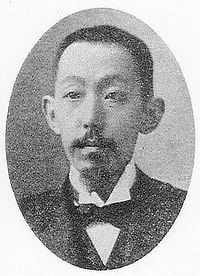Shō Ten
| Shō Ten | |
|---|---|
 Marquis Shō Ten | |
| Born |
September 2, 1864 Shuri, Okinawa |
| Died |
September 20, 1920 (aged 56) Shuri, Okinawa |
| Nationality | Japan |
| Occupation | Politician |
| Known for | last Crown Prince of the Ryūkyū Kingdom |
Shō Ten (尚典, September 2, 1864 – September 20, 1920) was the last crown prince of the Ryūkyū Kingdom (中城王子 Nakagusuku Ōji, lit. Prince of Nakagusuku). He lost that title upon the abolition of the kingdom and the abdication of the king, his father, Shō Tai, in 1879, and later succeeded to the title of Marquis (侯爵 kōshaku) in the kazoku peerage following his father's death in 1901.
Biography
Shō Ten was born in Shuri and was from birth crown prince to the Ryūkyū Kingdom. He underwent his coming of age ceremony in 1878 and was married the same year.
In March 1879, his father Shō Tai formally abdicated upon the orders of the Meiji government, which abolished the kingdom, transforming Ryūkyū domain into Okinawa Prefecture, with officials appointed from Tokyo to administer the islands[1] The former king was ordered to report to Tokyo, but feigning illness, he temporarily found shelter at Shō Ten’s palace. Shō Ten was sent to Tokyo as a hostage and partial appeasement as Ryūkyūan officials searched for ways to delay the former king’s departure.[2] Following his father's death and his succession as Marquis and head of the Shō family in 1901, Shō Ten and his family gave up the trappings of traditional Ryūkyūan royal court life, costume, court language, and ritual, and adopted those of the Japanese peerage.
As Marquis, Shō Ten held a hereditary seat in the House of Peers in the Imperial Diet. He was joined in representing Okinawa by a Japanese resident appointed to represent the prefecture's wealthiest taxpayers for the first time in 1918.[3]
The Marquis died on September 20, 1920 in his mansion in Shuri and was entombed six days later in Tamaudun, the royal mausoleum near Shuri Castle, in accordance with traditional Ryūkyūan royal funerary rites. He would be the last member of the Shō family to be honored in such a manner.[4] The family head was succeeded by his eldest son Shō Shō (尚昌), then to Hiroshi Shō.

| Preceded by Shō Tai |
Shō family head 1901-1920 |
Succeeded by Shō Shō |